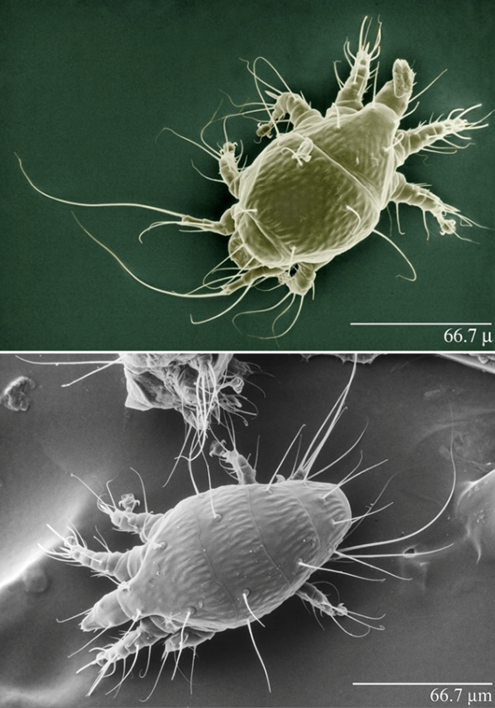One sometimes overlooked pest of the honey bee is the microscopic tracheal mite, Acarapis woodi. This well named species of mite invades the trachea of honey bees causing scaring and maldevelopment. This poses an economic threat for beekeepers due to overall reduced colony health and possible losses. These mites, found all over the world and causing Acarine disease, may swiftly wipe out colonies. Read this blog to gain insight about the life cycle of these mites.
The Life Cycle of a Tracheal Mite
Tracheal mites, Acarapis woodi, have a parasitic relationship with honey bees. Once these mites have entered the bee, they usually live in the bee’s trachea but have also been found to infest air sacs of the bee’s abdomen and head 1. Due to their small size, a microscope is required to diagnose an infestation. Males are about 125-135 µm long with a width of 60-77 µm 1. Female tracheal mites are larger, with an approximate length of 120-190 µm and a 77-80 µm width 1.
The life cycle of the Honey Bee Tracheal Mite (HBTM) begins when it hatches from an egg inside the bee’s trachea. The larva pierces through the trachea and feeds on hosts hemolymph 2 which surrounds the honey bees’ tissues and is a part of the open circulatory system 3. Hemolymph, composed of amino acids, sugars, proteins, inorganic ions and other substances, is the main food for mites 3. While only feeding on the bees, the males develop within 11-12 days 2. Female Tracheal mites have longer development time of about 14-15 days, then they mate and exit their current host to find a new one.
To locate a new host, female tracheal mites will exit the trachea through the spiracle opening and crawl onto the hairs of the bee 2. They often look for a new host at night 1. When travelling mites are at risk of falling off the bees, and they can die within a few hours if they do not enter a host 4. Females prefer young, newly emerged bees since they have longer life cycles 2. They are able to distinguish young bees from older bees because they are attracted to the air expelled from the young bee’s prothoracic spiracle 4. Tracheal mites are also attracted to the specific hydrocarbons from the bees’ cuticle 1. The proportions of hydrocarbons change depending on honey bee age 5. Once the female has entered the new honey bee’s tracheal system, she can lay about 1 egg a day, for around 8-12 days 2. The eggs measure 5 to 15 µm longer than the female mite1.
Adult (right) and larval (arrowed) honey bee tracheal mite in a trachea using an LT-SEM microscope (Sammataro et al. 2013)
Honey bee tracheal mites are difficult to find, and can multiply rapidly, causing significant damage not only to individual bees but also to entire hives. Winter can be particularly critical, because of bees being in compact clusters make them vulnerable to mite infestations. Understanding the behaviour and impact of these creatures is essential for maintaining healthy bee colonies.
Written by Kaitlyn Newton, Seasonal Apiculturist
References:
- Sammataro, D., de Guzman, L., George, S., Ochoa, R. and Otis, G., 2013. Standard methods for tracheal mite research. Journal of Apicultural Research, 52(4), pp.1-20.
- Sammataro, D. and Avitabile, A., 2021. The beekeeper’s handbook fifth addition. Cornell University Press.
- Feng, M., Ramadan, H., Han, B., Fang, Y. and Li, J., 2014. Hemolymph proteome changes during worker brood development match the biological divergences between western honey bees (Apis mellifera) and eastern honey bees (Apis cerana). BMC genomics, 15, pp.1-13.
- Sammataro, D., Gerson, U. and Needham, G., 2000. Parasitic mites of honey bees: life history, implications, and impact. Annual review of entomology, 45(1), pp.519-548.
- Vernier, C.L., Krupp, J.J., Marcus, K., Hefetz, A., Levine, J.D. and Ben-Shahar, Y., 2019. The cuticular hydrocarbon profiles of honey bee workers develop via a socially-modulated innate process. Elife, 8, p.e41855.


